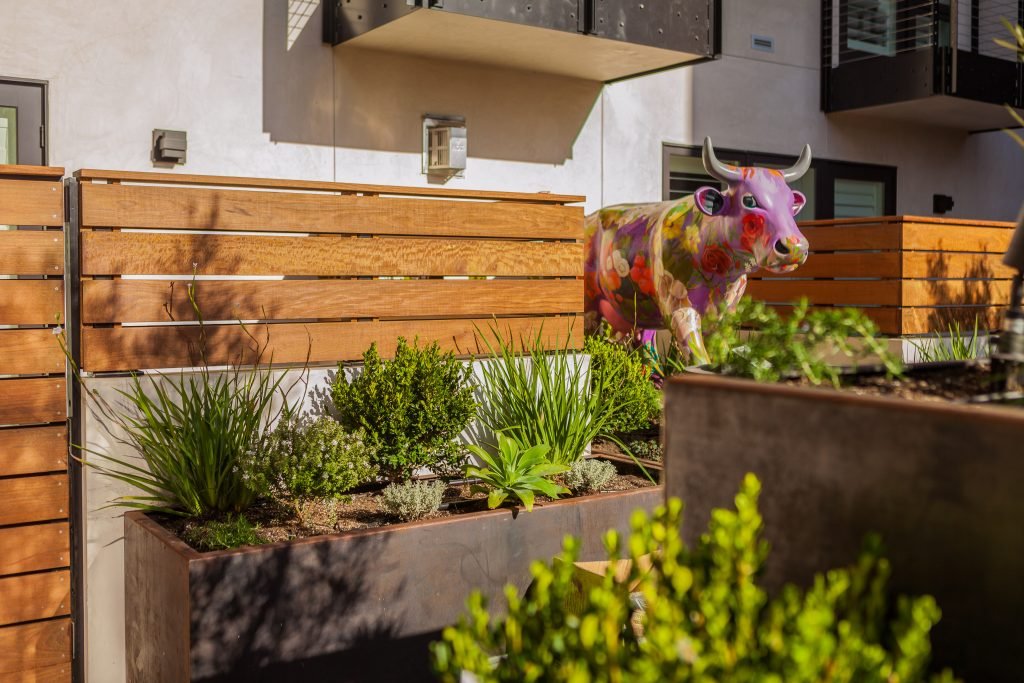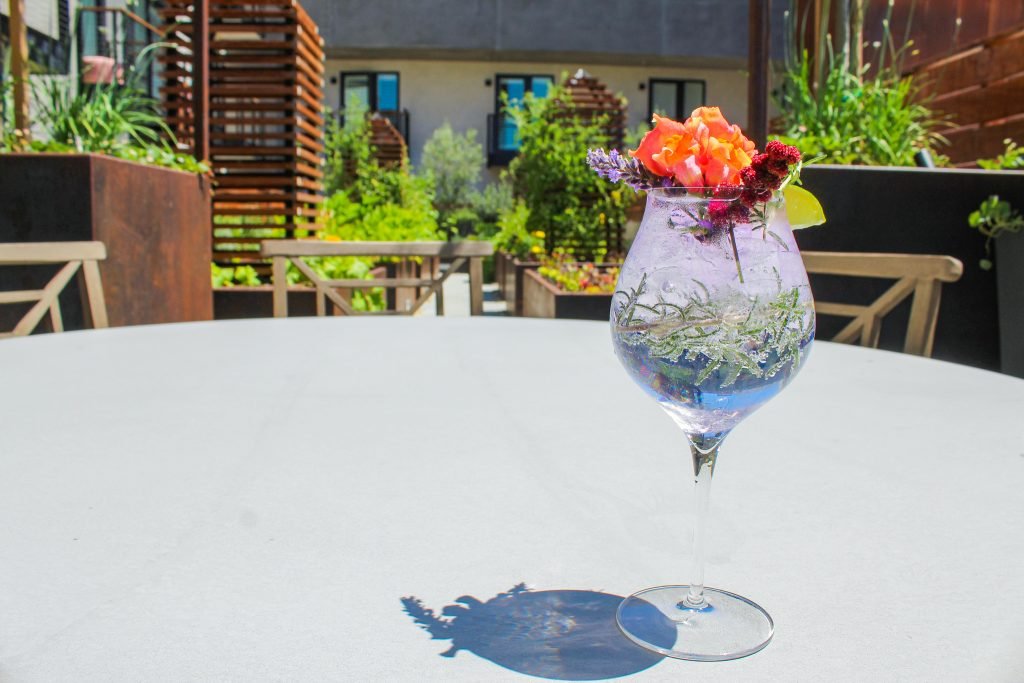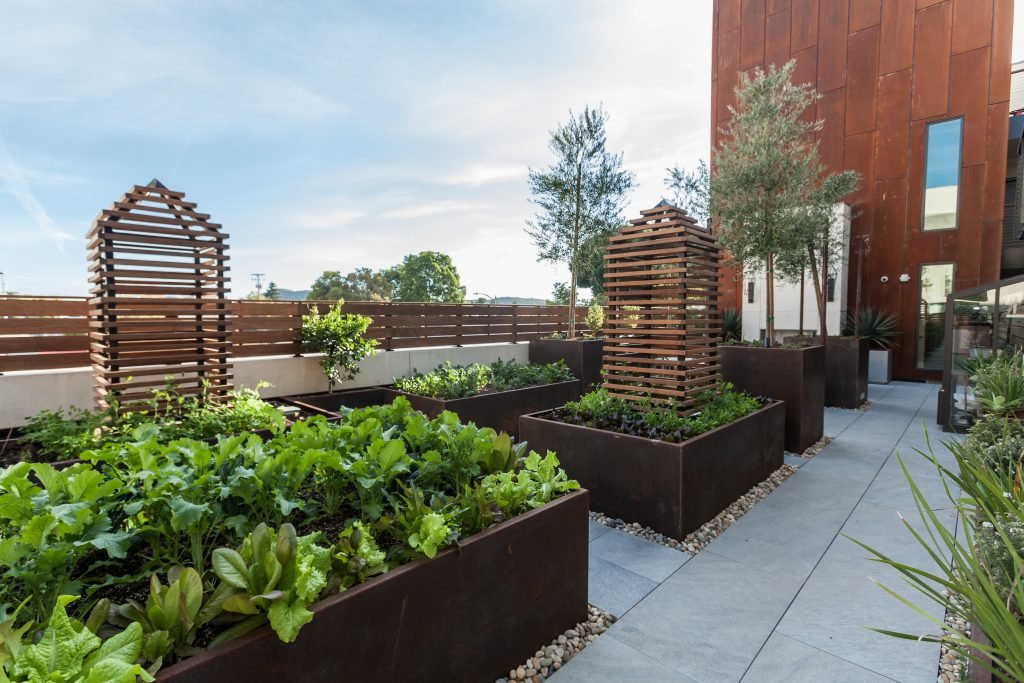
Visit An Edible Garden High Up On a Hotel Rooftop
Photos: Courtesy of Hotel Cerro and Kelsey Prins
High up on the rooftop of SLO’s charming Hotel Cerro, the Edible Gardens blossom. Isis candy tomatoes glint like topaz stones, perfumed by the heady scent of tomato leaves, and deep scarlet-hued roselle hibiscus flowers unfurl their tightly-curled heads to the morning sun. Just a few feet away, plum-colored little finger eggplants grow five in a row, resembling a giant’s hand. Over a little bubbling fountain, a purple cow sculpture named Seraphina presides as Hotel Cerro’s mascot. She sports a red face mask and contentedly watches over a crew of bees buzzing amongst the lavender.

But there’s a catch to this secret garden — it’s for Hotel Cerro guests only. Guests can gain access to this spacious second-story haven at any time of the day or night, where they can imbibe cocktails perfumed by the very ingredients surrounding them. And from their garden suite rooms, guests can view the verdant space and enjoy a drink on their own private patio, warmed by a private fire bowl.
“We wanted a space for people to come and enjoy, and you don’t really picture a garden in the middle of downtown,” Kelsey Prins, Marketing Manager, said. “It’s a unique and special aspect you don’t often see in a hotel, and it’s a very relaxing environment where people can come up and enjoy a glass of wine or our charcuterie and just relax.
To Prins, the space has served a dual purpose during the quarantine. “(The garden) is also about creating space for community, which is a little different at the moment in that it’s transitioning to the outdoors.”
Originally landscaped by Annette Pollock of Avante Gardener, the Edible Gardens is SLO’s contribution to the blooming of worldwide vertical urban gardenscapes, which make use of upper stories to feed city dwellers. Its facilities include a stately white stainless steel and glass fireplace installed by Forden’s, benches to sit on, an outdoor garden, and a greenhouse, the latter two carefully tended by gardener Christine Nielsen.
Hotel guests can trip down to the hotel’s other outdoor spaces, Brasserie SLO’s front veranda or the Mission Fig patio, for a full dinner outdoors, and then head up to the Edible Gardens to chat with one another from afar. Diners are being distanced, Prins says, which is easy because the hotel has heat lamps and fireplaces throughout its outdoor spaces.
Though you can only visit the garden as a hotel guest, dining at the hotel’s restaurants or bar will allow you to taste the fruits of the Edible Gardens. The Spanish Gin and Tonic served in the hotel’s bar, The Distillery, features mashed lavender and rosemary from the Edible Gardens, and is garnished with snapdragon flowers from the garden. (You can find that recipe below.)

You’ll even feel the effect of the gardens when you visit the hotel’s spa, which makes uses of the small spa garden on the roof. At the spa, edible flowers, mint and rose petals are used in the foot baths, as well as for house-made scrubs and shampoo.
Nielsen believes it’s an important environmental step for hotels to nurture gardens, and sees the outsized benefit to hotel guests as well.
“First of all, you’re helping the environment — the bees, the carbon footprint, using organic matter and not using pesticides is helpful for the environment,” Nielsen said. “Also, you’re just helping people in general have an appreciation for the outdoors and nature.”

Summer is an abundant time in the Edible Gardens. Nielsen is growing biergarten sage, oregano za’atar, echinacea, calendula snow princess, and various microgreens in the greenhouse. In the garden, she’s nurturing alexandria strawberries, black pear tomatoes, berita lina cucumbers, purple ruffles basil, costa romanesco squash, csiskos botermo tomato, black beauty eggplants, white Italian cucumbers, banana and pepino melons, yacon, and strawberry spinach.
Come fall, Nielsen’s gardening efforts will shift in concert with the fall menu Chef James has planned for Brasserie SLO, Hotel Cerro’s restaurant.
“I just actually met with Chef James and he wants to plant some black kale, some more edible flowers, so that we can add them in the dishes, since it’s such a nice little touch,” Nielsen said. “I asked him what he’s typically interested in and he said ‘Things that are unusual, things that I’ve never seen before.’”

Nielsen emphasizes the need for produce that’s as beautiful as it is delicious for a restaurant like Brasserie SLO. A larger supply of greens will be on Nielsen’s shovel and James’ plate, with plans for a panoply of microgreens, including tiny leaves of pretty red sorrel. Nielsen will also plant more lettuce, wasabi arugula, and kale.
“(The wasabi arugula) is so cool — it has the spice of the wasabi and then also a little bit of spice of the arugula, so it’s just amazing,” Nielsen said.
Nielsen aims to plant a wide variety of beets for fall, including golden beets and red-and-white chioggia beets. She also hopes to successfully farm broccoli and cauliflower, which may soon show up on the menu at Brasserie SLO.
Nielsen knows that her efforts aren’t going to waste, with the veggies heading to the restaurant and bar, but her love for the gardens goes beyond locavorism.
“(The Edible Gardens) help with general well-being, especially during these times,” Nielsen said. “It brings some peace.”
Spanish Gin and Tonic
Recipe by: The Distillery at Hotel Cerro
- 1½ ounces Forager gin
- ½ ounce Empress Gin
- 1 bottle Source tonic (200 ml, or 6.75 ounces)
- Splash of Sprite
- Lavender
- Rosemary
- Snapdragon flower garnish
Pour both types of gin in a highball glass filled with ice cubes. Top with other liquid ingredients.
Stir gently to combine, but not so much that you lose carbonation.
Garnish with lavender and rosemary, and float the snapdragon flower on top. For visual purposes, you can also arrange and prop several stems of dragonflowers in the glass in a small bouquet.
Note: If you don’t have Forager gin, sub a very juniper-forward gin like Tanqueray. If you don’t have Empress Gin, its taste and color can be difficult to replicate, but you can sub a sweet, floral gin like Hendrick’s.

